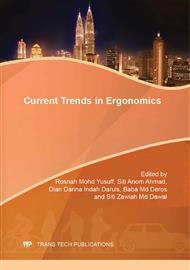p.327
p.331
p.336
p.345
p.351
p.357
p.361
p.367
p.373
Amber Position Lamp as Daytime Running Light for Motorcycle
Abstract:
The ability for motorcycle to be detected is an important aspect in preventing crash involving motorcycle which is the most dominant vehicle in emerging countries. Widely referred as conspicuity, the crash factor is appropriately addressed by the introduction of mandatory daytime running light (DRL) law and is usually a success story in many parts of the world. In 2011, there was a motion introduced in the 64thsession of the United Nations Working Party on Lighting and Light-Signalling (GRE) for amber position lamp (APL) to be made mandatory on motorcycle as additional measure to improve motorcycle conspicuity. An experiment was designed to evaluate conspicuity level of motorcycle headlamp and tail lamp equipped with APL over motorcycle with present DRL setting (baseline). 15 participants simultaneously rated both motorcycles which are placed in parallel, at different distances and times of day. Motorcycle with APL was noticeably better detected from rear than front at 50 meter and 100 meter distance, as well as during night time and twilight. Median conspicuity level between night time and daytime and between night time and twilight was also distinctly different for rear lamp. These findings suggest that APL introduction could enhance motorcycle conspicuity especially for rear lamp position.
Info:
Periodical:
Pages:
357-360
Citation:
Online since:
December 2013
Authors:
Keywords:
Permissions:
Share:
Citation:


